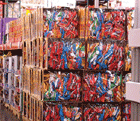Jim Sinegal, President of Costco Wholesale, once said that retail activities of goods must have both "show" and "sexy" components. This is why the "packaging" of the product in the retail chain must be noticeable, not just the brown box.
One skill that retailers use to create excitement in the store is to create a "treasure hunt" atmosphere, which means to surprise shoppers and get new experiences in the store. Simon Williams, CEO of Sterling Group, the world's leading consulting firm in New York, sees it as "a pinball game that allows customers to search around the store."
Nowadays, treasure hunt methods have been applied everywhere in the retail industry, including high-level stores like Costco, as well as one dollar stores. Importantly, "packaging" can be a technique that can promote the sale of products in a treasure hunt atmosphere.
Costco is a recognized expert in treasure hunts. According to the report in "Package Stores and Others Department Store" published by Packaging Strategy, the company adopted a method of rotating many commodities in a store to make customers feel that each of their shopping routes is different.
A typical Costco store has more than 4,000 items, and as part of the treasure hunt, about 1,000 of them will be replaced on a regular basis.
How can product packaging support this sales strategy? Williams owns a company with a reputation for packaging design, and he summarizes the top five techniques that packers can use to support this strategy and promote sales. 
Frito-Lay's collection of merchandise display in the store attracted people's attention.
Collective display products
"People need to be attracted to the show. It's not just about the product's packaging. It's also about how to enchant the customer, how to make the customer stay, look and buy." Williams explained.
This factor has prompted the display pallet to be widely used in the United States. The key is to create a visual impact and minimize the burden on retailers. Supermarkets often only want to transport the pallets to the floor of the store, and do not need to invest additional manpower to set display effects.
“You need to attract people, make people interested, and change them,†Williams continued. “The treasure hunt method is not just to pile up the goods, and then sell them cheaply.â€
One example is Frito-Lay's fast food display pallets for hypermarket environments. There are 42 individual small packages in each package on a finely printed fiber pallet. This diversity of packages is primarily aimed at companies that own vending machines, but it also attracts large home users. The pallet uses a glossy, very transparent film package that further enhances the visual impact.
These pallets were placed vertically on the cargo platform, creating a strong collection and display effect through the brilliant colors of various small packages, which promoted the sales of products.

General Mill uses a die-cut fifth-side box to enhance information transmission and visual impact.
Enhanced information
“The traditional way to reinforce information is to use words, but the exemplary role of people should also be taken into account. The packaging itself is a silent salesman, and usually, you need to start a dialogue with the customer first,†explains Williams. You must use relevant methods to establish contact with customers."
This is a demanding requirement for packaging because packaging is basically a passive medium.
However, a recent example has pushed "packaging" to a more active role. That is the Flex-A-Min Dietary Supplement (a supplement for enhancing joints and cartilage) introduced by the New York Arthritis Research Foundation. It uses a "flash" box, in which a battery is printed to drive a small light bulb that can be flashed on the shelf to increase attractiveness. The company also uses a small lens on the box to create the effect of simulated motion and further enhance the communication of information.
Another packaging technology that appeals to shoppers is the "five-sided" carton. The General Mills Company of the United States used a remarkable "five-sided" carton for its Franken Berry cereals to attract consumers. The folding surface of the carton has a die-cut cut, and in this cut-out position there is a monster's paw, which looks like it is tearing a hole in the box. It establishes a connection with shoppers outside the visual and strengthens the information of the goods. 
Malt-O-Meal's display transport box constitutes a promotional area to attract customers to purchase.
(to be continued)